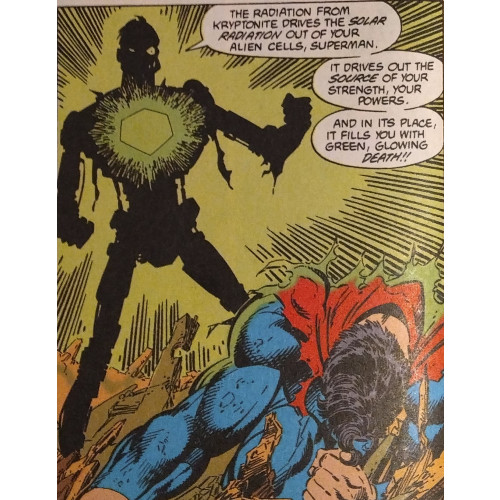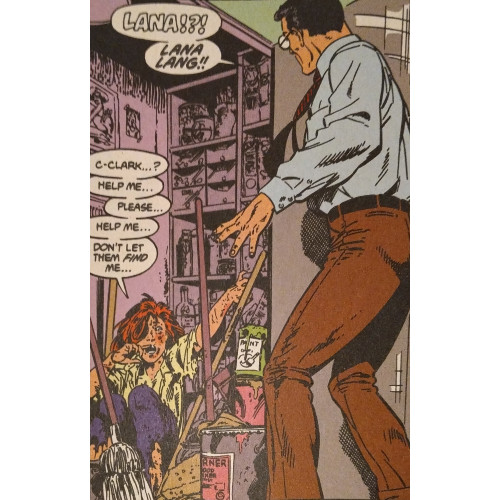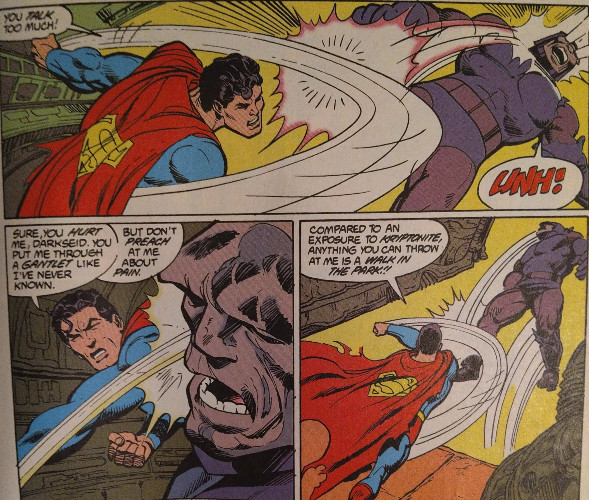Distinguished Critique: Superman: The Man of Steel (vol. 2) Review
Somewhat divided in nature, this volume works best when defining John Byrne's vision for the post-Crisis Superman
—by Nathan on April 16, 2025—

In 1986, in the wake of Crisis on Infinite Earths, John Byrne was given the opportunity to redefine DC Comics' First Son: Superman. Across a six-issue limited series, Byrne brought Kal-El into what was then the modern age, and though I personally enjoy other modernizations of Superman's formative years more, I cannot deny Byrne's impact on the character and his world. I wasn't too thrilled with his Superman coming across as a little "Americanized," forgoing his Kryptonian heritage in favor of his Kansas upbringing. But I got a kick out of how Byrne reframed Lex Luthor, Bizarro, Lois Lane, even Batman.
With the success of the limited series, Byrne was allowed to spearhead a new ongoing Superman series, the first few issues of which are collected here. What I wasn't aware of when I picked up this volume is that subsequent "Man of Steel" collections also included issues of Superman's other ongoing titles, Action Comics and The Adventures of Superman. Three different series and a few different creators comprise the contents of this volume. While Byrne takes on the lion's share, some other folks seek to leave their mark on the Man of Steel. We'll see if I feel their attempts bounce off like bullets or burn in like a kryptonite brand.
Superman: The Man of Steel (vol. 2)
Writers: John Byrne and Marv Wolfman
Pencilers: John Byrne and Jerry Ordway
Inkers: Terry Austin, Dick Giordano, Mike Machlan, and Jerry Ordway
Colorist: Tom Ziuko
Letterers: John Costanza and Albert T. DeGuzman
Issues: Superman #1-3, Action Comics #584-586, The Adventures of Superman #424-426, and Who's Who Update '87
Publication Dates: January 1987-March 1987, August 1987

I've read this volume twice; the first time, I entered completely unaware of the three titles presented. I had, erroneously, assumed the volume continued Byrne's take on Superman through the hero's titular series…and that it did so exclusively. I wasn't expecting three different series, and so I finished the volume feeling a little cheated by its construction. I hoped a second readthrough would provide me with a different perspective. And it did…mostly.
A good 66% of this volume represents Byrne's vision, as he writes and pencils both Superman and Action Comics. These issues, primarily, allow us a good look into how he continues establishing the Man of Steel. A narrative involving Lex Luthor carries between both series, issues formatted next to each other to maximize the story's fluidity–chapters unfold as they should, with a hint of a larger plot at the end of the very first Superman issue continuing through Action Comics #584 and Superman #2. It all reads fairly well, Byrne's command of the larger narrative, told in bits, maintaining the reader's interest. You want to see what happens next–how is Lex Luthor connected to the new version of Mentallo? How does a tease at the end of Action Comics #584 unfold into the next issue?

It's the first two Adventures of Superman issues, written by Marv Wolfman, which provide some turbulence. The problem isn't that they're necessarily bad stories; it's that they cut in the middle of the narrative Byrne is presenting, prying you away from an overarching plot to tales which feel less important to drum up interest in a tertiary series tacked on to the character because of his popularity. The counterargument presented is that the latter third of the volume is devoted to a Legends crossover (more on that in a minute) which connects all three titles, thus disrupting Byrne and Adventures writer Marv Wolfman's plots anyway but allowing them to find temporary synergy where Wolfman's narratives otherwise interrupt Byrne's. You can argue that, absolutely, and I won't disagree. Part of me just believes that the first two Wolfman issues could have been excised in favor of including more Byrne material after the Legends crossover, which definitely needs the Adventures issue to finish its tale.
But, as I said, that's more of a hangup with the volume composition than the material presented. Wolfman's two issues, if we examine them alone, aren't quite as endearing as Byrne's take on the character. They're a little goofier in nature, focusing on several dangerous yet oddly colorful robots which later assemble themselves Tinker Toy style to form a bigger, badder robot. Is the visual cool? Sure, to a certain extent. But Jerry Ordway's design strips most of the seriousness out of the thing, creating robots which feel like toys. A more cynical person might suggest they were intended to appeal to children for merchandising purposes. I have no idea if that was actually the case, however, so I'll stick with the critique that they feel, visually, out of place.

Wolfman tries to work some grimmer material into this volume in an effort to achieve a balance Byrne feels more at home with: the light and the dark combined. A scientist is beaten for his invention; he later performs an experiment which accidentally murders a man. Elsewhere, terrorists topple part of a building and die in an attempt to bring war to America. Wolfman plays these elements with as straight a face as he can, but something about his take doesn't sit as well with me. Part of me wants to blame Ordway who, though no slouch in the penciling department, cannot bring the same gravitas and detail as Byrne supplies. The Adventures issues also feel slightly differently colored and shaded, providing more of a "comic" book look to them, perhaps subconsciously convincing me to not treat them as seriously. Whatever the case, they're an awkward inclusion.
Byrne pushes for additional realism in his stories, toeing the line between darkness and lightness more finely. Part of the appeal of the original Man of Steel series is how enjoyable it is. The limited series gave us a lighter Superman, balancing out the dark and gritty nature of his best buddy Batman. In a world where Watchmen and The Dark Knight Returns reigned supreme, Superman promised a lighter touch, a beacon of hope in the midst of darkness. Shortly into the main series, Byrne draws in some darker elements, but these pieces feel artfully placed. The sight of a bloody and tortured Lana Lang is absolutely shocking, but it aligns with the more real-world machinations of Lex Luthor: he's a bully and manipulator, and he's just as soon to have thugs kidnap and torture a friend of Clark Kent's or drug his parents and ransack their home as he is to develop bizarre (some might even say "bizarre-o") experiments and supervillains. Byrne's Luthor feels more menacing than a host of terrorist soldiers with their killing machines. He's just a man, but he manages to hold even Superman at bay. His cold cruelty adds a touch of the deeper shadows readers could find in Byrne's later work for Dark Horse, Next Men, showcasing the looser restrictions Byrne dealt with. Superman was still a mainstream DC title (and it's, y'know, Superman), and though Byrne seems allowed to have pushed the confines a little, I assume he didn't have the freedom creators could have on prestige limited series, such as Returns or Mike Grell's Longbow Hunters.

Despite the presumed limitations, Byrne and Wolfman endeavor to bring a level of real world circumstance to their narratives, casting a superhumanly powerful alien being into a world which, with a few adjustments, could be ours. Wolfman's terrorists are intended to evoke memories of attacks of the age in which these stories written and can, unfortunately, capably bring to mind horrors of our own modern age. Byrne's Luthor is rich and manipulative, and I don't need to espouse much on why presenting a character in such a light would cause a strong reaction with readers over the last forty years. Superman in these stories isn't meant to just be a hero, he's meant to be our hero, paneled wish fulfillment. He's supposed to stand up to the men who would cause us harm, given the chance. Some of this may be derived from a statement he makes at the end of Man of Steel, where he notes his American upbringing and patriotism. Those tones are muted in these issues, at least, but this is a Superman who will protect truth, justice, and the American Way from enemies both without and within.
I think Byrne succeeds in this admirably, for the reasons outlined above, and partially because he crafts a Superman who can stand up to injustice but not always succeed, who can be weakened and occasionally lacks an outlet through which his powers are sufficient. Deadly kryptonite appears to menace our Man of Steel, and the sight of Luthor physically removing a weakened Superman from his office is momentarily demoralizing. Likewise, traps and tricks seek to harm or discourage him at every turn, whether it's a crazed scientist switching brains with Superman or Mentallo on a rampage. Not every situation can be solved by Clark punching his way through his foes, and the Big Blue Scout has to use that big, not-blue brain from time-to-time.

I'll also give credit to how the creators handle a three-issue tie-in to DC's first post-Crisis company-wide crossover, Legends. Written by John Ostrander and penciled by Byrne, the six-issue series sought to reestablish the company's primary heroes in a post-Crisis universe, along with implementing some new blood. I criticized the series in my review for too heavily revolving around a single concept and word pairing, causing annoyance rather than generating a powerful theme throughout the narrative. Byrne and Wolfman pivot away from the limited series' primary narrative in these Superman issues–by sending Superman to Apokolips, they avoid a potential conundrum when President Reagan bans all superhuman activity in Legends.
What follows is a fairly entertaining story with a brainwashed Superman that hinges on a pretty engaging twist halfway through that changes the remainder of the narrative's tone. I somewhat scoffed at the twist when I first read the volume, thinking it too abrupt. After a second read, however, I appreciate the direction Bryne and Wolfman take the arc. Cast as the savior for a rebellion against Darkseid, Superman is manipulated against his will, creating a decent conflict between himself and a few New Gods for a portion of the story's finale. The tale points to Darkseid's deviousness far better than Legends, while hinting at the seeming futility in definitively defeating the dark god. We're given a small victory, somewhat usurped by a more complex defeat which strikes at Superman's soul. Like in Legends, Darkseid is largely a puppeteer, but his involvement here feels far more personal and, in certain panels, is more direct, casting him as a supremely powerful threat to the entire DC Universe.

If Byrne's Man of Steel limited series was meant to reintroduce Superman to a waiting world, then these issues build off that bedrock, further entrenching his new vision in readers' minds. There's a blend here of what I have come to call "Silver Age silliness" (see: the Tinker Toy robots) and more genuine attempts at serious drama (the menace of Lex Luthor and Darkseid) as DC finds its groove in the post-Crisis Bronze Age. Part of me does wish this were all Byrne's material, as I find his vision more compelling than I do Wolfman's, but I will give credit to the creative teams for congealing late in the volume to create the strong three-parter on Apokolips. Throughout the volume, however disparate the tone feels at times, we are given a singular Man of Steel, a hero for the then-modern day and age, ready to tackle any threats to himself and those he loves, whether they be angry scientists, scheming alien overlords, or a bald businessman wishing to destroy the power he craves but can never possess.